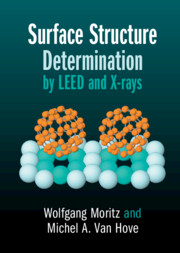Book contents
- Surface Structure Determination by LEED and X-rays
- Surface Structure Determination by LEED and X-rays
- Copyright page
- Contents
- Preface
- List of Abbreviations
- List of Major Symbols
- Glossary
- 1 Introduction
- 2 Basic Elements
- 3 LEED Experiment
- 4 Interpretation of the Diffraction Pattern
- 5 LEED Theory
- 6 LEED Theory
- 7 Surface X-ray Diffraction
- Appendices
- References
- Index
7 - Surface X-ray Diffraction
Published online by Cambridge University Press: 18 August 2022
- Surface Structure Determination by LEED and X-rays
- Surface Structure Determination by LEED and X-rays
- Copyright page
- Contents
- Preface
- List of Abbreviations
- List of Major Symbols
- Glossary
- 1 Introduction
- 2 Basic Elements
- 3 LEED Experiment
- 4 Interpretation of the Diffraction Pattern
- 5 LEED Theory
- 6 LEED Theory
- 7 Surface X-ray Diffraction
- Appendices
- References
- Index
Summary
X-ray diffraction is the main tool used to obtain the atomic structure of 3-D crystals. The relatively weak interaction of the X-ray beam with matter and the resulting large penetration depth makes it insensitive to structural details in a small surface area: the surface is therefore usually neglected in structure determinations of 3-D crystals. This has changed with the development of synchrotron radiation as an X-ray source which provided new applications in X-ray crystallography. The very high intensity and angular resolution of the synchrotron beam allow the study of numerous effects which had been considered too weak to detect with laboratory X-ray sources. It has been shown, however, that with intensive X-ray sources that are available now, the structure analysis at surfaces is also possible in the laboratory.
- Type
- Chapter
- Information
- Surface Structure Determination by LEED and X-rays , pp. 285 - 361Publisher: Cambridge University PressPrint publication year: 2022

